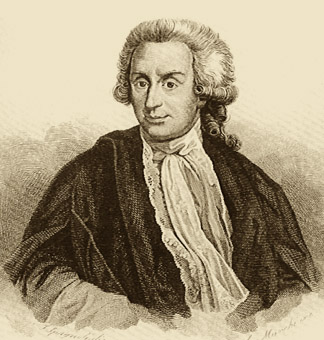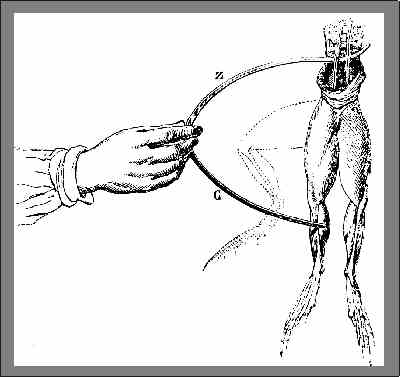Handout #10: Luigi Galvani (1737-1798)
A century and a half after Galileo's death, something of scientific importance was to develop in Italy. During the 1780's, biologist Luigi Galvani performed experiments at the University of Bologna involving electric charges and frogs.
 Galvani was a dedicated physician, and medicine, tracing its lineage back to tribal shamans, has always been a blend of intuition and empirical observation based on a vitalistic concept of the sanctity of life. The vitalists had long tried—unsuccessfully—to link the strange, incorporeal phenomenon of electricity with the “vitalizing spirit” thought to be the animating principles of life itself. This was Galvani's main preoccupation.
Galvani was a dedicated physician, and medicine, tracing its lineage back to tribal shamans, has always been a blend of intuition and empirical observation based on a vitalistic concept of the sanctity of life. The vitalists had long tried—unsuccessfully—to link the strange, incorporeal phenomenon of electricity with the “vitalizing spirit” thought to be the animating principles of life itself. This was Galvani's main preoccupation.
One day he noticed that some frogs' legs he'd hung from brass hooks in a row on his balustrade, pending his dinner, twitched whenever the breeze blew them against the ironwork. At about the same time his wife Lucia noticed in his laboratory that the muscles of a frog's leg contracted when an assistant happened to be touching the main nerve with a steel scalpel at the same instant that a spark leaped from one of the electrical machines being operated across the room. (The only type of electricity then known was the static type, in the form of sparks from various friction devices.)
Galvani knew that metals transmitted this mysterious substance called electricity, and came to the obvious conclusion that some kind of electricity - which he called "animal electricity" - was generated in the tissue of the frog and, flowing through the metal skewer and fence, activated the frog's muscles. He distinguished this kind of electricity from "artificial electricity" generated by friction (static electricity) and from "natural electricity" such as lightning. He thought of "animal electricity" as a fluid secreted by the brain, and proposed that flow of this fluid through the nerves activated the muscles.

Today we know that an expanding and collapsing electric field generated by the spark induced a momentary current in the scalpel, which stimulated the muscle, but Galvani believed that the metal railing and scalpel had drawn forth electricity hidden in the nerves.
Galvani experimented for years with nerves from frogs' legs, connected in various circuits with several kinds of metals. He grew convinced that the vital spirit was electricity flowing through the nerves and announced this to the Bologna Academy of Science in 1791. Within two years, Alessandro Volta, a physicist at the University of Padua, had proven that Galvani had in fact discovered a new kind of electricity, a steady current rather than sparks. He'd generated a bimetallic direct current, a flow of electrons between two metals, such as the copper hooks and iron railing of the famous balcony observation, connected by a conducting medium—in other words, a battery. The frogs' legs, being more or less bags of weak salt solution, were the electrolyte, or conducting medium. They were otherwise incidental, Volta explained, and there was no such thing as Galvani's "animal electricity."
 Galvani, a shy and thoroughly noncombative soul, was crushed. His only response was an anonymous paper in 1794 describing several experiments in which frogs' legs could be made to twitch with no metal in the circuit. In one procedure, the experimenter touched one leg nerve with the frog's dissected-out, naked spinal cord, while holding the other leg to complete the circuit. Here the current was true animal electricity, coming from the amputation wound at the base of the leg.
Galvani, a shy and thoroughly noncombative soul, was crushed. His only response was an anonymous paper in 1794 describing several experiments in which frogs' legs could be made to twitch with no metal in the circuit. In one procedure, the experimenter touched one leg nerve with the frog's dissected-out, naked spinal cord, while holding the other leg to complete the circuit. Here the current was true animal electricity, coming from the amputation wound at the base of the leg.
Galvani's remarkable experiments helped to establish the basis for the biological study of neurophysiology and neurology. The paradigm shift was complete: nerves were not water pipes or channels, as Descartes and his contemporaries thought, but electrical conductors. Information within the nervous system was carried by electricity generated directly by the organic tissue. As the result of the experimental demonstrations carried out by Luigi Galvani and his followers, the electrical nature of the nerve-muscle function was unveiled. However, a direct proof could only be made when scientists could be able to measure or to detect the natural electrical currents generated in the nervous and muscular cells. Galvani did not have the technology to measure these currents, because they were too small.
Luigi Galvani was appointed Reader in Anatomy at the University in 1762. His skill as a surgeon soon won him the Chair of Obstetrics at the Institute of Sciences, of which he was to become president in 1772. His investigations into the structure of animal organs established him as one of the founders of modern electro-technology at the end of the eighteenth century, alongside his contemporaries Henry Cavendish, Benjamin Franklin and Alessandro Volta. He was the first to discover the physiological action of electricity. His subsequent experiments in making the exposed muscles and nerves of a frog contract when connected to a demonstrated the existence of bioelectric forces in animal tissue.
 This gave rise to a disagreement between Galvani and Volta over the explanation of the phenomenon, about which each was partly right. His work was nevertheless instrumental in leading Volta to the invention of the first electric battery. Galvani held his Chair for 33 years but was dismissed in 1797 following the occupation of the country by the Napoleonic army. Being a man of integrity, he refused to take the oath of allegiance required of him by the invader. He died the following year.
This gave rise to a disagreement between Galvani and Volta over the explanation of the phenomenon, about which each was partly right. His work was nevertheless instrumental in leading Volta to the invention of the first electric battery. Galvani held his Chair for 33 years but was dismissed in 1797 following the occupation of the country by the Napoleonic army. Being a man of integrity, he refused to take the oath of allegiance required of him by the invader. He died the following year.
The name Galvanization is derived from Luigi Galvani, and was once used as the name for the administration of electric shocks (also termed in the 19th century Faradism, named after Michael Faraday), this stems from Galvani's induction of twitches in severed frog's legs, by his accidental generation of electricity. This now archaic sense is the origin of the meaning of galvanized when used to describe someone stirred to sudden, abrupt action.
Home